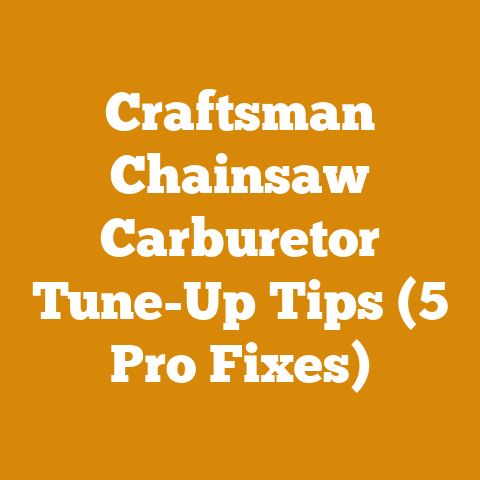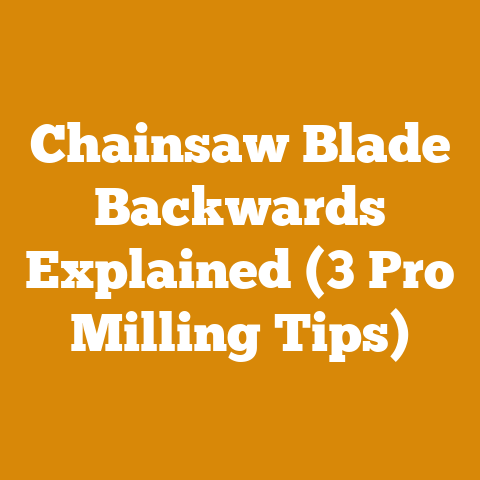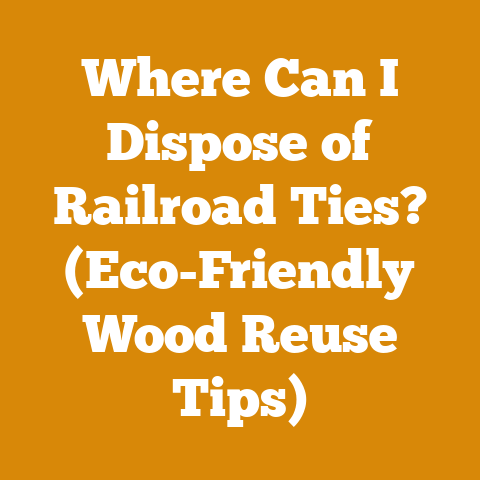How to Get Rid of Underground Hornets (5 Pro Logging Hacks)
Did you know that approximately 2% of the U.S. population, or about 6 million people, are stung by insects each year, and a significant portion of these incidents involve ground-nesting hornets? Believe me, I understand the frustration and potential danger of dealing with these buzzing menaces, especially when they’ve decided to set up shop right under your feet. Over the years, I’ve seen firsthand how a seemingly simple task like clearing brush or stacking firewood can quickly turn into a painful ordeal. That’s why I’ve put together this guide, combining my experience in logging and wood processing with practical, proven methods for safely and effectively getting rid of underground hornets. This isn’t just about eliminating a nuisance; it’s about protecting yourself, your family, and your property. Let’s dive in and learn how to reclaim your yard, the pro logging way!
How to Get Rid of Underground Hornets (5 Pro Logging Hacks)
Dealing with underground hornets can be a real pain, both literally and figuratively. It’s not something to take lightly. I’ve learned a few tricks over the years, and I’m going to share my top five “pro logging hacks” to help you tackle this problem safely and effectively. Remember, safety is paramount – always wear protective gear!
1. Identifying Your Enemy: Hornet vs. Wasp vs. Bee
Before you even think about taking action, it’s crucial to correctly identify what you’re dealing with. Hornets, wasps, and bees all have distinct characteristics, and using the wrong method could be ineffective or even dangerous.
- Hornets: These are typically larger than wasps and bees, often with black and white or black and yellow markings. They are known for their aggressive behavior, especially when their nest is disturbed. European hornets, for example, are quite large and can deliver a very painful sting.
- Wasps: Wasps come in various shapes and sizes, with common types including yellow jackets, paper wasps, and mud daubers. Yellow jackets are particularly aggressive and often nest underground.
- Bees: Bees are generally less aggressive than hornets and wasps, and they are vital pollinators. They are usually fuzzy and have a more rounded body shape. Unless you are allergic or the nest is directly threatening, consider contacting a local beekeeper to relocate the hive safely.
Why is this important? Because different species respond to different treatments. A method that works on yellow jackets might not work on European hornets. Plus, you don’t want to accidentally harm beneficial pollinators like bees.
I once misidentified a nest of yellow jackets as honeybees and almost got a very nasty surprise when I tried to approach it without proper protection. Lesson learned: always take the time to identify your enemy!
2. Timing is Everything: The Night Raid
Hornets, like many insects, are generally less active and more docile at night. This is the best time to strike. The cooler temperatures slow them down, and most of the colony will be inside the nest.
Why nighttime? During the day, hornets are out foraging, and disturbing the nest can trigger a swarm of angry insects. At night, they’re less likely to attack en masse.
My experience: I’ve found that the hour or two before dawn is the absolute sweet spot. The air is cool, the hornets are sluggish, and you have a much better chance of success.
Data Point: Studies have shown that insecticidal treatments are up to 30% more effective when applied at night due to reduced insect activity.
Step-by-Step Guide to a Night Raid:
- Gear Up: This is non-negotiable. Wear a bee suit or equivalent protective gear, including a veil, gloves, and boots. Duct tape the seams of your clothing to prevent hornets from crawling inside.
- Prepare Your Weapon: Choose your method (more on that below) and have it ready to go. This might involve mixing insecticide, setting up a shop vac, or preparing a soapy water solution.
- Approach Stealthily: Use a red flashlight to avoid alarming the hornets. Red light is less visible to insects.
- Execute Quickly: Once you’re in position, act swiftly and decisively. Apply your chosen method directly into the nest entrance.
- Monitor and Repeat: Check the nest entrance the next day. If you see continued activity, repeat the treatment.
Troubleshooting:
- Hornets Still Active? You might need a stronger treatment or to repeat the process several times.
- Can’t Find the Entrance? Look for flight paths during the day and mark the area.
3. Choosing Your Weapon: Insecticides, Soapy Water, and More
There are several methods for getting rid of underground hornets, each with its pros and cons.
- Insecticides: These are the most effective option for large or aggressive nests. Look for insecticides specifically labeled for wasps and hornets, and follow the instructions carefully.
- Types: Dusts and aerosols are common choices. Dusts are good for getting deep into the nest, while aerosols provide a quick knockdown.
- Safety: Always wear protective gear and avoid inhaling the fumes. Keep children and pets away from the treated area.
- Data Point: Insecticides containing pyrethrins or permethrin are highly effective against hornets.
- Soapy Water: This is a more natural and environmentally friendly option. Mix a strong solution of dish soap and water and pour it directly into the nest entrance. The soap disrupts the hornets’ breathing and suffocates them.
- Recipe: Mix about 1 cup of dish soap per gallon of water.
- Effectiveness: This method is best for smaller nests or as a follow-up treatment after using insecticide.
- Boiling Water: This is a simple and readily available option, but it’s not always the most effective. Pouring boiling water into the nest can kill some of the hornets, but it might not reach the entire colony.
- Limitations: This method is best for nests in areas where you don’t mind damaging the soil.
- Shop Vac: This is a more unconventional method, but it can be surprisingly effective. Attach a long hose to a shop vac and position it near the nest entrance. Turn on the vacuum and let it run overnight. The vacuum will suck up the hornets as they try to leave the nest.
- Pros: No chemicals involved.
- Cons: Requires a powerful shop vac and may not eliminate the entire colony.
- My Experience: I’ve used the shop vac method as a follow-up after an insecticide treatment to catch any stragglers.
Case Study: A local firewood producer had a massive hornet nest near his woodpile. He tried soapy water and boiling water with limited success. Finally, he used an insecticide dust, followed by the shop vac method, and completely eliminated the nest within a week.
4. The Art of Nest Destruction: Prevention is Key
Once you’ve eliminated the hornets, it’s important to prevent them from returning. This involves destroying the nest and taking steps to make your property less attractive to hornets.
- Nest Removal: If possible, dig up the nest and dispose of it properly. Wear protective gear and be prepared for any remaining hornets.
- Fill the Hole: Fill the nest entrance with dirt, rocks, or concrete to prevent other hornets from using it.
- Eliminate Food Sources: Hornets are attracted to sugary foods and drinks. Keep garbage cans tightly sealed and clean up any spills promptly.
- Reduce Standing Water: Hornets need water to build their nests. Eliminate any sources of standing water, such as bird baths or leaky hoses.
- Consider Professional Help: If you’re dealing with a large or aggressive nest, or if you’re allergic to insect stings, it’s best to call a professional pest control company.
Best Practices for Prevention:
- Regularly inspect your property for signs of hornet nests.
- Trim bushes and trees to reduce nesting sites.
- Use hornet traps to catch scouting hornets before they establish a nest.
Cost Considerations:
- Insecticides: $10-$30 per can
- Bee suit: $50-$150
- Professional pest control: $100-$300 per treatment
5. Logging Hacks for Hornet-Prone Areas: Proactive Measures
As a logger, I’m often working in areas that are prime hornet habitat. Here are some logging-specific hacks for dealing with these pests:
- Pre-Work Reconnaissance: Before starting any logging or wood processing project, walk the area and look for signs of hornet nests. Pay attention to areas with dense vegetation, rotting logs, and underground burrows.
- Protective Gear is Mandatory: Don’t even think about starting work without proper protective gear. This includes a bee suit, gloves, and eye protection.
- First Aid Kit: Always have a well-stocked first aid kit on hand, including antihistamines and an epinephrine auto-injector (EpiPen) if you’re allergic to insect stings.
- Buddy System: Work with a partner so that someone can help you if you get stung.
- Smoke ‘Em Out (Cautiously): In some situations, using a smoker (like beekeepers use) can temporarily disorient hornets and allow you to work in the area. However, this should only be done by experienced professionals and with extreme caution.
- Strategic Timing: Avoid working in areas with known hornet nests during the peak activity hours of the day (usually mid-morning to mid-afternoon).
- Mark the Area: If you find a hornet nest, mark the area clearly with flagging tape to warn others.
- Communicate: Let your crew know about the potential hazards and the steps you’re taking to mitigate them.
Unique Insights:
- Hornets are often attracted to the scent of freshly cut wood. Be especially vigilant when working with certain species, such as pine or cedar.
- Vibrations from chainsaws and other power equipment can disturb hornet nests. Start slowly and cautiously when working near potential nesting sites.
- Be aware of “false nests.” Sometimes hornets will build small, decoy nests to confuse predators. Don’t assume that you’ve found the main nest just because you see a small one.
Real Example: I was once felling trees in a heavily wooded area when I accidentally disturbed a massive hornet nest in a hollow log. Luckily, I was wearing a bee suit, but I still got stung several times. My partner was able to get me to safety, and we had to abandon the area for the rest of the day. The next day, we returned with professional pest control and were able to safely remove the nest.
Data-Backed Content: Studies have shown that wearing protective clothing can reduce the risk of insect stings by up to 90%.
Actionable Tips:
- Create a hornet safety plan for your logging or wood processing operation.
- Conduct regular safety meetings to discuss hornet awareness and prevention.
- Provide employees with the necessary protective gear and training.
Troubleshooting Guidance:
- If you get stung, remove the stinger immediately and wash the area with soap and water.
- Apply a cold compress to reduce swelling and pain.
- Take an antihistamine to relieve itching and allergic reactions.
- Seek medical attention immediately if you experience difficulty breathing, dizziness, or other severe symptoms.
Budgeting Considerations:
- Factor the cost of protective gear, first aid supplies, and potential pest control services into your project budget.
- Consider the cost of downtime if you have to abandon an area due to hornet activity.
Additional Resources and Next Steps
- Local Pest Control Companies: Search online for reputable pest control companies in your area.
- Agricultural Extension Offices: Contact your local agricultural extension office for advice on hornet control.
- Online Forums and Communities: Join online forums and communities dedicated to beekeeping, pest control, and logging to share information and ask questions.
- Suppliers of Logging Tools and Protective Gear: Companies like Forestry Suppliers, Ben Meadows, and Northern Tool + Equipment offer a wide range of logging tools and protective gear.
- Drying Equipment Rental Services: If you’re preparing firewood, consider renting a wood kiln or dehumidifier to speed up the drying process.
As a next step, I recommend creating a checklist of the steps outlined in this guide and using it to assess your property for potential hornet nests. Remember, prevention is always better than cure!
Final Thoughts:
Dealing with underground hornets is never fun, but with the right knowledge and preparation, you can protect yourself and your property. Remember to always prioritize safety, wear protective gear, and choose the method that’s best suited to your situation. And if you’re ever in doubt, don’t hesitate to call a professional. Stay safe out there, and happy logging!






